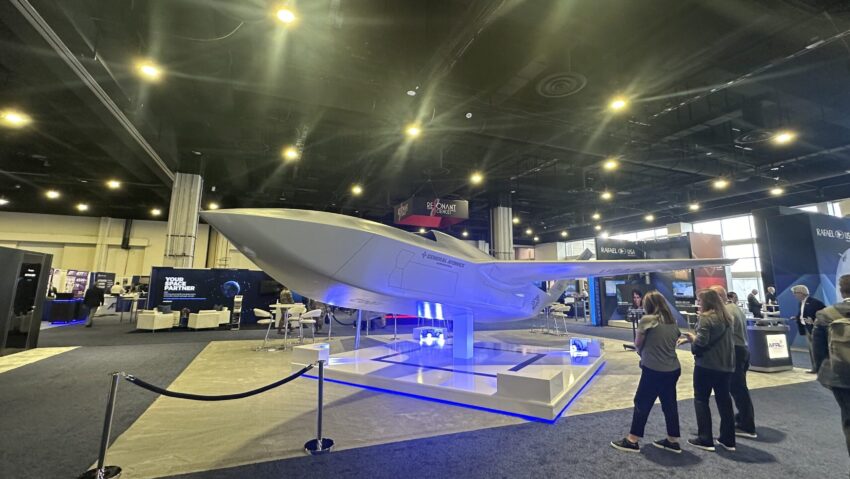General Atomics Aeronautical Systems shows off its design for a Collaborative Combat Aircraft at AFA 2024 (Valerie Insinna/Breaking Defense)
WASHINGTON — Drone maker General Atomics has unveiled a plan to manufacture drone wingmen in Germany, amid a global push to bolster airpower through manned-unmanned teaming.
The company will tap General Atomics Aerotec Systems GmbH (GA-ATS), an affiliate based near Munich, to manufacture the drones and customize their mission systems for European customers, according to a Thursday press release. General Atomics plans to use the company’s YFQ-42A developed by the General Atomics Aeronautical Systems (GA-ASI) team in San Diego for the US Air Force’s Collaborative Combat Aircraft (CCA) program as the baseline platform for European production.
The “completely separate” German-based affiliate — which boasts about 400 employees and performs aircraft manufacturing as well as maintenance, repair and overhaul — brings a “tremendous amount of capability,” said GA-ASI President Dave Alexander, enabling the company to move quickly into production. Alexander, who spoke by phone with Breaking Defense on Thursday following the announcement, declined to comment on a delivery schedule, citing sensitive timelines with prospective European buyers.
C. Mark Brinkley, a spokesman for General Atomics, said in response to follow-up questions from Breaking Defense that existing facilities at GA-ATS can support a “substantial European program.” Additional investments in Europe, if any, “would be driven by future partnerships and individual nation needs,” Brinkley said, where GA-ATS would serve “as a lead system integrator” across various European programs “to provide economies of scale and streamline interoperability.”
Amid its foray into European markets as NATO nations push to increase defense spending, Alexander noted that different requirements for the drone wingman mission open up opportunities for new partners, potentially sweetening the deal for countries who will want their own industrial bases to play a role. Europe currently has two competing sixth-generation fighter programs in development, both of which envision flying alongside drone wingmen, alongside legacy aircraft that could also be supplemented by a drone teammate.
RELATED: Belgian defense minister says FCAS, GCAP 6th-gen fighter projects show Europe failing to integrate
Specifically, Alexander said that the YFQ-42A will need to be adapted for Europe to focus on air-to-ground missions, as opposed to a current priority on air-to-air missions as the US Air Force eyes a potential conflict in the Indo-Pacific.
“That immediately opens up a lot of opportunity for the sensor suite that’s in the platform,” Alexander said. Noting the aircraft is “very modular,” he added that “we can pull the equipment out that does the air-to-air mission and look at putting those indigenous sensors from Europe in partnerships for the air- to-ground.”
The same situation applies to the aircraft’s AI software, which Alexander said will also need to be tailored for defeating ground-based targets.
“The beauty of that is, this autonomy and the AI can be developed by whoever wants to come in there and provide that into the mission systems part of it,” Alexander said, referencing an open architecture standard. “So that’s also up for grabs, because the air-to-air autonomy is going to be different skills, and the air-to-ground will be new skills.”
General Atomics is just the latest American company to announce drone production plans for Europe, following announcements from competitors like Kratos who recently announced a partnership with Airbus. There’s also Anduril, who is facing off against General Atomics for the US Air Force’s CCA program and has inked a production deal with Rheinmetall for the company’s Fury drone.
Asked how General Atomics plans to prevail in an increasingly saturated market, Alexander chiefly pointed to his firm’s status as a global company, as well as the investment the US Air Force has made in the YFQ-42A.
“If you want to utilize that initial benefit of all that investment from the US Air Force, that’s one thing. If you’re trying to glom on to something that’s on the sidelines, you’re getting a sideline product,” he said. Pointing to the US Air Force CCA program, he added, “We are the program of record. And if you want to be in on that, it’s General Atomics.”
Click this link for the original source of this article.
Author: Michael Marrow
This content is courtesy of, and owned and copyrighted by, https://breakingdefense.com and its author. This content is made available by use of the public RSS feed offered by the host site and is used for educational purposes only. If you are the author or represent the host site and would like this content removed now and in the future, please contact USSANews.com using the email address in the Contact page found in the website menu.








